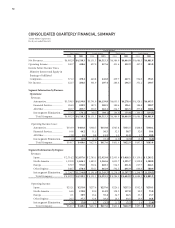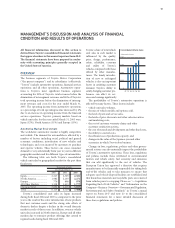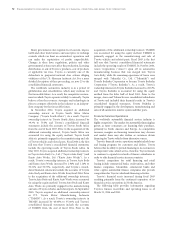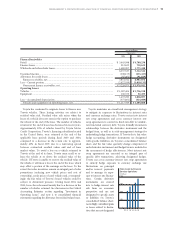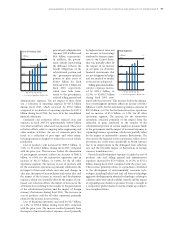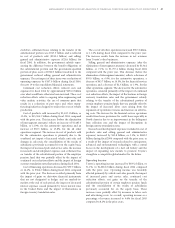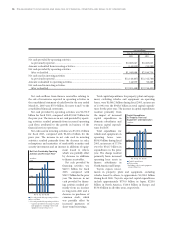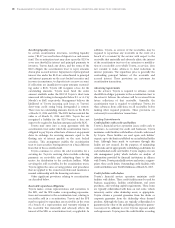Toyota 2005 Annual Report Download - page 62
Download and view the complete annual report
Please find page 62 of the 2005 Toyota annual report below. You can navigate through the pages in the report by either clicking on the pages listed below, or by using the keyword search tool below to find specific information within the annual report.
60 >MANAGEMENT’S DISCUSSION AND ANALYSIS OF FINANCIAL CONDITION AND RESULTS OF OPERATIONS
financing operations which increased during fiscal 2004 by
1.3% to ¥716.7 billion compared with the prior year.
Eliminating the difference in the yen value used for
translation purposes, net revenues from sales of products
would have been approximately ¥16,809.1 billion, a 13.6%
increase, and net revenues from financing operations
would have been approximately ¥745.2 billion, a 5.3%
increase, during fiscal 2004 compared with the prior year.
Net revenues for fiscal 2004 increased by 8.3% in Japan,
33.3% in Europe and 53.0% in all other markets and
decreased by 0.3% in North America compared with the
prior year. Eliminating the difference in the yen value used
for translation purposes, net revenues would have
increased by 8.3% in Japan, 7.1% in North America,
25.3% in Europe and 48.9% in all other markets com-
pared with the prior year.
The following is a discussion of net revenues for each of
Toyota’s business segments. The net revenue amounts
discussed are amounts before the elimination of interseg-
ment revenues.
Automotive Operations Segment
Net revenues from Toyota’s automotive operations
constitute the largest percentage of Toyota’s net revenues
and increased by ¥1,662.3 billion, or 11.6%, to ¥15,973.8
billion during fiscal 2004 compared with the prior year.
The increase resulted primarily from the approximately
¥1,300.0 billion impact attributed to increased vehicle unit
sales, the ¥420.0 billion impact attributed to the consolida-
tion of the results of subsidiaries previously accounted for
on the equity basis, as discussed in note 5 to the con-
solidated financial statements, and increased parts and
service sales. These increases were partially offset by the
¥230.0 billion impact of foreign currency translation rates
fluctuations. Eliminating the difference in the yen value
used for translation purposes, automotive operations
revenues would have been approximately ¥16,205.2 billion
during fiscal 2004, a 13.2% increase compared to the prior
year. Net revenues in Japan were favorably impacted by
vehicle unit sales growth in both of the domestic and
export markets, that were offset by lower average unit sales
prices resulting from the continuing market shift in Japan
to lower priced vehicles during fiscal 2004. Net revenues in
North America were favorably impacted by vehicle unit
sales growth, but were partially offset by the negative
impact of foreign currency fluctuations during fiscal 2004.
Net revenues in Europe were favorably impacted by
combined net impact of vehicle unit sales growth and
changes in sales mix, and foreign currency translation rate
fluctuations during fiscal 2004. Net revenues in all other
markets were favorably impacted by vehicle unit sales
growth, but were partially offset by the lower average unit
sales price.
Financial Services Operations Segment
Net revenues for Toyota’s financial services operations
increased by ¥12.0 billion, or 1.6%, to ¥736.9 billion
during fiscal 2004 compared with the prior year. This
increase resulted primarily from the impact of a higher
volume of financings and the impact of expansion of the
credit card business in Japan that was partially offset by
the impact of foreign currency translation rates
fluctuations during fiscal 2004. Eliminating the difference
in the yen value used for translation purposes, financial
services operations net revenues would have been
approximately ¥765.0 billion during fiscal 2004, a 5.5%
increase compared with the prior year.
All Other Operations Segment
Net revenues for Toyota’s other businesses increased by
¥101.0 billion, or 12.7%, to ¥896.2 billion during fiscal
2004 compared with the prior year. This increase resulted
primarily from the impact of increased production
volume and sales from the housing business.
Operating Costs and Expenses
Operating costs and expenses increased by ¥1,398.0
billion, or 9.8%, to ¥15,627.9 billion during fiscal 2004
compared with the prior year. The increase is comprised
of approximately ¥1,000.0 billion, primarily from the
impact on cost of products attributed to increased vehicle
unit sales, a ¥470.0 billion impact from the consolidation
of the results of subsidiaries previously accounted for on
the equity basis, a ¥110.0 billion impact of increase in
labor costs, and the impact of increased parts and service
sales. These increases were partially offset by the
approximate ¥230.0 billion impact of cost reduction
efforts and a ¥107.0 billion net gain on the transfer of the
substitutional portion of certain employee pension funds
in Japan.
In 2001, the Corporate Defined Benefit Pension Plan
Law was enacted and allowed a company to transfer the
substitutional portion of the obligation to the govern-
ment. The parent company and certain subsidiaries in
Japan applied for an exemption from the payment of
benefits related to future employee services with respect to
the substitutional portion of their employee pension funds
and obtained approval from the Minister of Health, Labor,
and Welfare. These companies also applied for approval
for the separation of the benefit obligations of the
substitutional portion which relates to past employee
services. After approval was obtained, the parent company
and certain subsidiaries completed the transfer of the
government-specified portion of plan assets relating to the
substitutional portion in fiscal 2004. In accordance with
the Emerging Issues Task Force (“EITF”) No. 03-02,
Accounting for the transfer to the Japanese Government of
the Substitutional Portion of Employee Pension Fund


